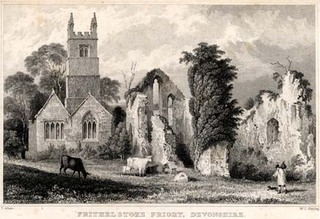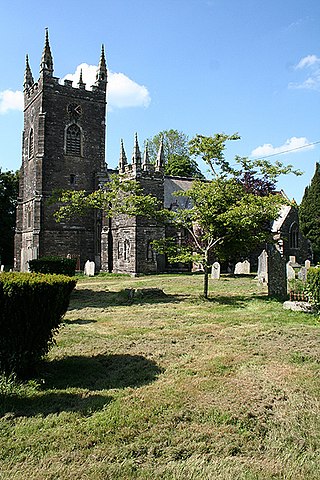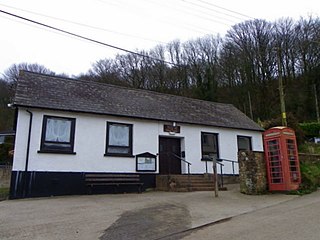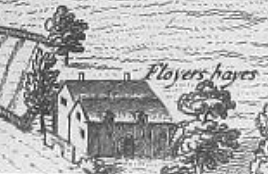
Earl of Devon is a title that has been created several times in the Peerage of England. It was possessed first by the Redvers family, and later by the Courtenay family. It is not to be confused with the title of Earl of Devonshire, which is held by the Duke of Devonshire, although the letters patent for the creation of the latter peerages used the same Latin words, Comes Devon(iae). It was a re-invention, if not an actual continuation, of the pre-Conquest office of Ealdorman of Devon.

Frithelstock Priory was founded in about 1220 at Frithelstock, Devon, England, by Sir Robert de Beauchamp for Augustinian Canons Regular, as an indulgence to ensure intercessions for the repose of his soul. Walter de Stapledon, Bishop of Exeter, is considered a co-founder, for increasing the priory's endowments.

Tavistock Abbey, also known as the Abbey of Saint Mary and Saint Rumon, is a ruined Benedictine abbey in Tavistock, Devon. Nothing remains of the abbey except the refectory, two gateways and a porch. The abbey church, dedicated to Our Lady and St Rumon, was destroyed by Danish raiders in 997 and rebuilt under Lyfing, the second abbot. The church was further rebuilt in 1285 and the greater part of the abbey between 1457 and 1458.

Werrington is a civil parish and former manor now in Cornwall, England, United Kingdom. Prior to boundary changes it straddled the Tamar and lay within the county of Devon. The portion on the west side was transferred to Cornwall in 1966. It is situated 1 mile (1.6 km) to the west of the Tamar, the traditional boundary between Devon and Cornwall, and 1 mile (1.6 km) north of Launceston.

Isabel de Forz was the eldest daughter of Baldwin de Redvers, 6th Earl of Devon (1217–1245). On the death of her brother Baldwin de Redvers, 7th Earl of Devon in 1262, without children, she inherited suo jure the earldom and also the feudal barony of Plympton in Devon, and the Lordship of the Isle of Wight. After the early death of her husband and her brother, before she was thirty years old, she inherited their estates and became one of the richest women in England, living mainly in Carisbrooke Castle on the Isle of Wight, which she held from the king as tenant-in-chief.

Hugh de Courtenay, 1st/9th Earl of Devon of Tiverton Castle, Okehampton Castle, Plympton Castle and Colcombe Castle, all in Devon, feudal baron of Okehampton and feudal baron of Plympton, was an English nobleman. In 1335, forty-one years after the death of his second cousin once-removed Isabel de Redvers, suo jure 8th Countess of Devon he was officially declared Earl of Devon, although whether as a new creation or in succession to her is unknown, thus alternative ordinal numbers exist for this Courtenay earldom.
Sir Hugh de Courtenay (1251–1292) was the son and heir of John de Courtenay, feudal baron of Okehampton, Devon, by Isabel de Vere, daughter of Hugh de Vere, 4th Earl of Oxford. His son inherited the earldom of Devon.

St James Priory, Exeter was a priory in Devon, England.
Modbury Priory was a Benedictine priory in the parish of Modbury, Devon, England, established before 1129 which was one of the longest surviving alien priories in England, most of which were suppressed in 1414. It was located close to the present parish church of St George in the town of Modbury, but its exact location is unclear.

Blackborough is a hamlet and former manor in the parish of Kentisbeare, Devon, England. It is situated within the Mid Devon district. The nearest substantial town is Cullompton, approximately 4.7 miles (7.6 km) to the south-west. Within Blackborough are situated the large mansion of Blackborough House also notable are Hayne Farm and the Old Smithy. The former neo-Gothic Early English style parish church of All Saints, built in 1838 by George Wyndham, 4th Earl of Egremont, lord of the manor, who also built Blackborough House was demolished in 1994, having become structurally unsafe. The churchyard however is still maintained and the ecclesiastical parish and parochial church council still exist.

Heanton Satchville was a historic manor in the parish of Petrockstowe, North Devon, England. With origins in the Domesday manor of Hantone, it was first recorded as belonging to the Yeo family in the mid-14th century and was then owned successively by the Rolle, Walpole and Trefusis families. The mansion house was destroyed by fire in 1795. In 1812 Lord Clinton purchased the manor and mansion of nearby Huish, renamed it Heanton Satchville, and made it his seat. The nearly-forgotten house was featured in the 2005 edition of Rosemary Lauder's "Vanished Houses of North Devon". A farmhouse now occupies the former stable block with a large tractor shed where the house once stood. The political power-base of the Rolle family of Heanton Satchville was the pocket borough seat of Callington in Cornwall, acquired in 1601 when Robert Rolle purchased the manor of Callington.

Sir Hugh Courtenay of Boconnoc in Cornwall, was twice a Member of Parliament for Cornwall in 1446–47 and 1449–50. He was beheaded after the Battle of Tewkesbury in 1471, together with John Courtenay, 7th Earl of Devon, the grandson of his first cousin the 4th Earl, and last in the senior line, whose titles were forfeited. His son Edward Courtenay, 1st Earl of Devon, was created Earl of Devon in 1485 by King Henry VII, following the Battle of Bosworth and the closure of the Wars of the Roses.

Nutwell in the parish of Woodbury on the south coast of Devon is a historic manor and the site of a Georgian neo-classical Grade II* listed mansion house known as Nutwell Court. The house is situated on the east bank of the estuary of the River Exe, on low-lying ground nearly contiguous to the water, and almost facing Powderham Castle similarly sited on the west bank. The manor was long held by the powerful Dynham family, which also held adjacent Lympstone, and was according to Risdon the site of their castle until John Dynham, 1st Baron Dynham (1433–1501), the last in the male line, converted it into "a fair and stately dwelling house".

The feudal barony of Okehampton was a very large feudal barony, the largest mediaeval fiefdom in the county of Devon, England, whose caput was Okehampton Castle and manor. It was one of eight feudal baronies in Devonshire which existed during the mediaeval era.

The Domesday Book of 1086 lists in the following order the tenants-in-chief in Devonshire of King William the Conqueror:

The feudal barony of Plympton was a large feudal barony in the county of Devon, England, whose caput was Plympton Castle and manor, Plympton. It was one of eight feudal baronies in Devonshire which existed during the medieval era. It included the so-called Honour of Christchurch in Hampshire, which was not however technically a barony. The de Redvers family, first holders of the barony, were also Lords of the Isle of Wight, which lordship was not inherited by the Courtenays, as was the barony of Plympton, as it had been sold to the king by the last in the line Isabel de Redvers, 8th Countess of Devon (1237–1293).

Floyer Hayes was an historic manor in the parish of St Thomas on the southern side of the City of Exeter in Devon, England, from which city it is separated by the River Exe. It took its name from the ancient family of Floyer which held it until the early 17th century, when it was sold to the Gould family. In the 19th century the estate was divided up and the manor house demolished. The parish church of St Thomas, situated a short distance to the west of the house, was burned down in 1645 during the Civil War, and was rebuilt before 1657. Thus no monuments survive there of early lords of the manor, namely the Floyer family.

Whiteway is an historic estate in the parish of Kingsteignton, Devon. It should be distinguished from Whiteway House in the parish of Chudleigh, Devon, 4 3/4 miles (7.6 km) to the north, in the 18th century a seat of the Parker family of Saltram.

















